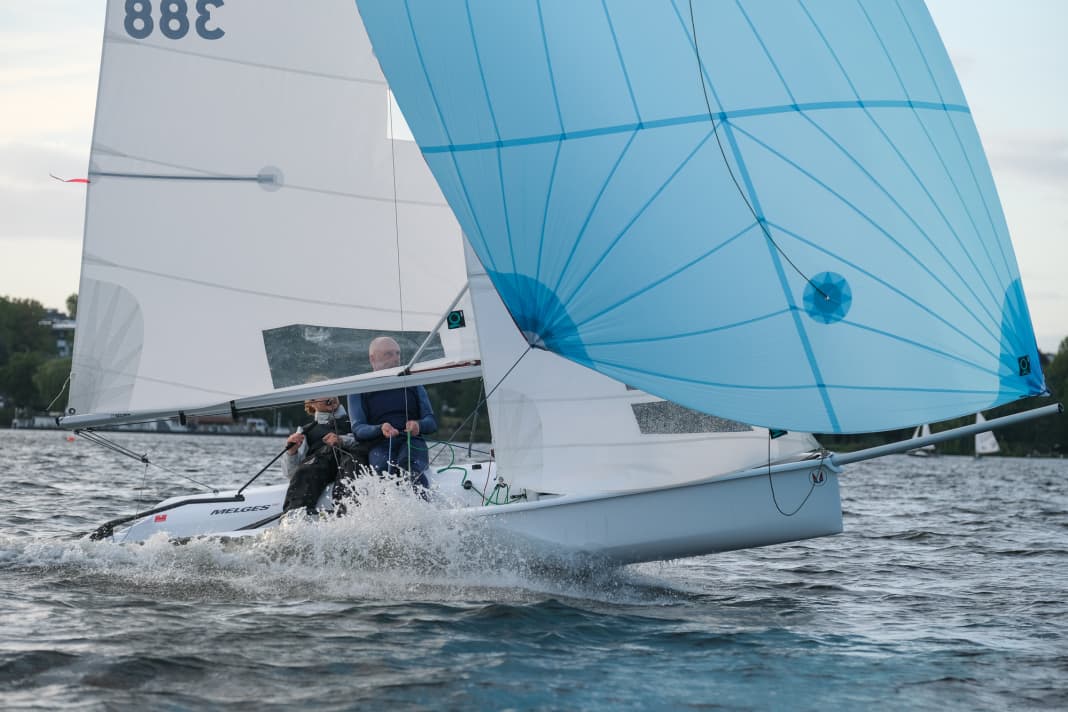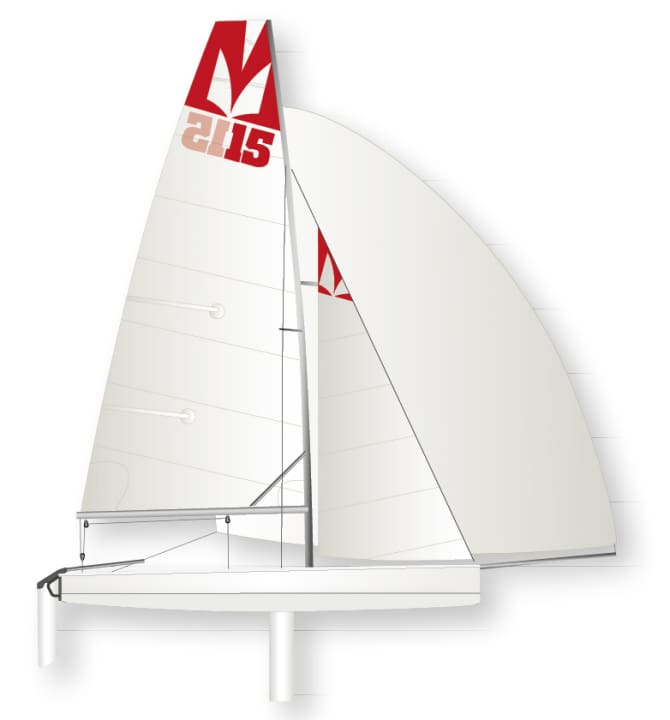





The Melges 15 has already been built over 500 times in its native USA, even though it only came onto the market two years ago. As a result, there are already large fields of the one-size-fits-all class at regattas there. The two-person dinghy did not appear in Europe until spring 2022, and can now be seen for the first time at boot in Düsseldorf. It is produced in Portugal by manufacturer Nelo, which is also experiencing brisk demand. We were able to test sail the dinghy on the Alster in Hamburg.
The almost 4.60 metre long boat is designed for two people. The hull has characteristic chine edges and is closed aft, which is almost retro. However, the latter has the advantage that the cockpit is lower (with an open stern, the cockpit would have to be higher to allow water to drain away), leaving more space for the foresailor to slip under the main boom or sit on the centreboard in light winds. The bow is open and accommodates the retractable gennaker pole as well as the recovery system. The space wind sail is set and recovered using a single-line system. The rest of the equipment is also kept simple, with no harness at all.
The sailing characteristics of the Melges 15
On the water, it turns out that this is not necessary. With two adults on board, the small boat is surprisingly stable in the water. The chines and the large beam aft provide plenty of righting moment. As a result, the Melges 15 remains very controlled even in moderate gusts of wind and there is no need to worry about capsizing. With two people on the edge, you can bring enough weight to windward, the dents are pleasantly rounded, so you can stand it on the edge even without special padding in your trousers. The Melges reacts sensitively to small rudder deflections, in gusts the mainsheet must be used actively, as the rudder effect is noticeably reduced if there is too much leeway.
But it never becomes uncontrollable. As soon as a little pressure is taken out or she is sailed more upright by riding out, the rudder effect is immediately there again. She can log over five knots on the wind without interruption. With a light shake in the sheets, the speed quickly increases to over six knots and the dinghy starts to planing. With half the wind, you can glide along at eight knots or more. This is where the advantage of the spacious and unobstructed cockpit becomes apparent: the weight can be easily shifted lengthways. This allows the bow to come out of the water nicely when sitting aft. Splash water finds its way into the boat, but runs off again immediately via the bilge pump. The Melges sails pretty wet. And sailing under gennaker? Although the crew of owner and tester are not well-rehearsed, it works perfectly.
The gennaker setup is intuitive- Sailing fun guaranteed
The Melges is easy and intuitive to sail, the gennaker set-up is super simple and makes for enormous sailing fun. During the first gybe, however, it turns out that we have inadvertently rigged the sheet around the outside, although the gennaker pole offers plenty of space to jibe the colourful cloth along the forestay on the inside. A quick step forwards and the mistake is rectified. The open bow is an advantage here, much safer compared to slipping on the covered bow of a 420. Now the jibes also work quickly, a plus point on the busy Outer Alster. In the short-lasting gusts, we easily log over ten knots, top speed is 12.5 knots. At this speed, the shore is quickly approaching in the small sailing area, and it's great that the gennaker is also recovered in record time.
The boat is manufactured quite elaborately in sandwich construction using vacuum infusion and the higher quality vinyl ester resin. The gelcoat on the test boat looked very good, with no sign of air pockets on edges or in corners. The rudder and centreboard are not made of GRP, but of aluminium. The lower edges, on the other hand, are made of replaceable plastic caps - very practical.
Sailing fun for everyone: The Melges 15 sails easily and intuitively and becomes really fast effortlessly
The basic price is 12,500 euros. The price includes the ready-to-sail boat with gennaker system. A slip trolley (375 euros), a tarpaulin (480 euros) and a bag for the centreboard and rudder (98 euros) are also required. A road trailer costs 1,550 euros. This adds up to 15,003 euros. In terms of price, the Melges 15 therefore lies between the 420 and the 29er.
It can only be compared with the former to a limited extent, as the 420 is a much older design: the round bilge makes it tippy and the spinnaker and trapeze make it more complex to handle. In terms of length and speed potential, the 29er is more suitable for comparison. But here, too, the harness makes it more difficult and more expensive to get on board. The Melges 15 is a boat that offers beginners a safe introduction as well as being good for a fast after-work session, but can also be sailed on the regatta course. Provided that sufficient numbers find their way to the sailing areas in Europe. There is no doubt that the boat has potential, thanks to its wide range of use, uncomplicated handling, high stability and of course the great fun factor, which immediately puts a big grin on the crew's faces.
On the boot Düsseldorf Melges 15 can be found in Hall 15 at Stand G 42.
The Melges 15 in detail

Technical data Melges 15
- Total length: 4.57 m
- Width: 1.67 m
- Draught (centreboard): 0.80 m
- Weight: 104 kg
- Mainsail: 8.7 m²
- Jib: 3.7 m²
- Gennaker: 14,5 m²
- Crew: 2 persons
- Designer: Reichel/Pugh
- Shipyard: Melges Performance Sailboats USA ( melges.com )
- Distribution: Hein Ruyten One Design Langweer Netherlands ( heinruyten.com )
Sailing performance (without drift/current)
Wind speed: 10 to 16 kn (3 Bft)
Wave height: approx. 0.1 m
- 45°: 5.5 kn
- 60°: 6.5 kn
- 90°: 8.0 kn
- 120° *: 9.0 kn
- 150° *: 11.0 kn
* with gennaker
Construction method
The glass fibres are impregnated with vinyl ester resin using vacuum infusion technology. Both the fuselage and cockpit shells are designed as a sandwich. The seat chines form the buoyancy bodies. An aluminium reinforcement in the centreboard box provides more stability
Equipment and prices
- Base price ex shipyard: € 12,500
- Price ready to sail : 15.003 €
- Warranty/against osmosis: 5/10 years
YACHT rating
The Melges 15 is a dinghy for two people, offering a high level of safety and easy handling. The price is reasonable
Design and concept
- + Easy to access sailing fun
- + Hull provides stability
- + Self-draining
Sailing performance and trim
- + single-line gennaker setup
- + Intuitive, fast sailing
- + Glides on quickly
Equipment and technology
- + Inverted kicker (Gnav)
- + attachments made from aluminium profiles
- + Retractable gennaker pole

